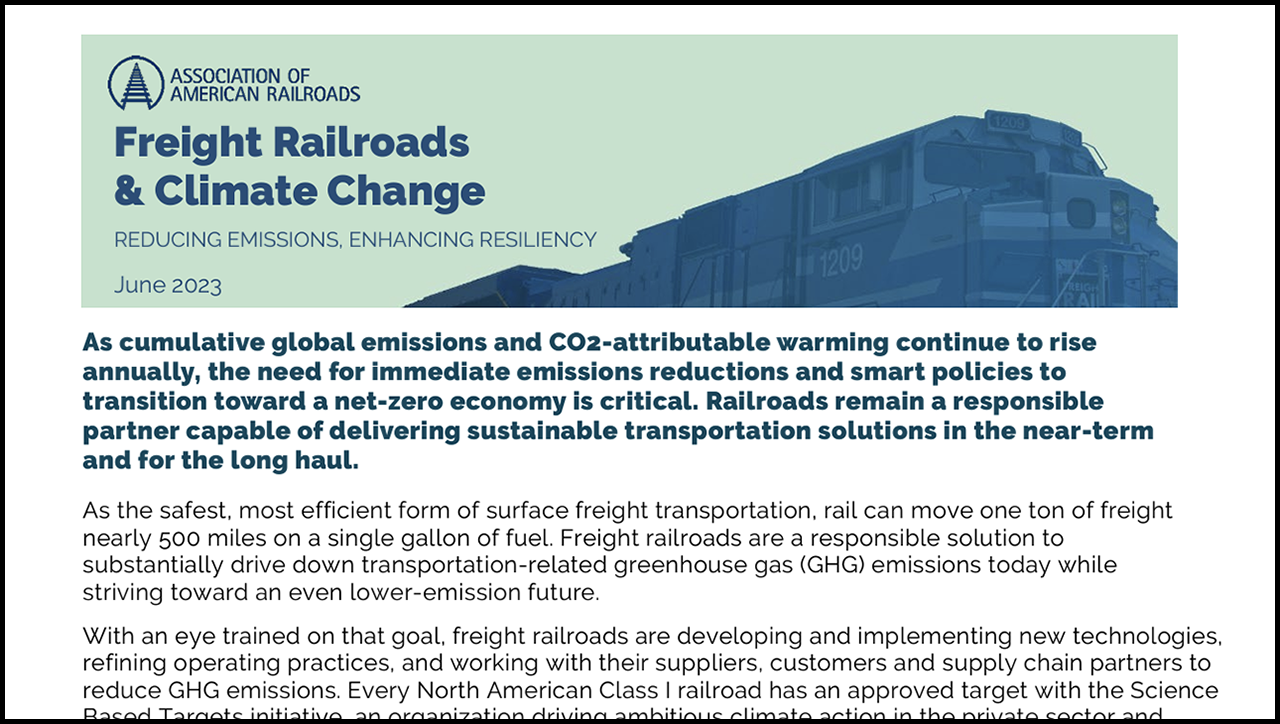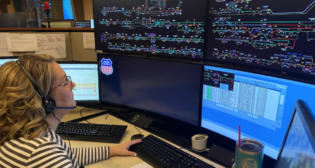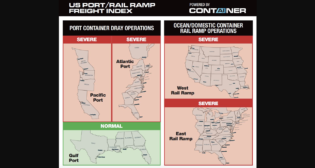
AAR to Policymakers: Advance ‘Pragmatic’ Policies on Climate Change
Written by Marybeth Luczak, Executive Editor
The Association of American Railroads (AAR) outlines how “smart” federal policies can further advance the rail industry’s efforts to combat climate change in new report released June 13.
“Policies must leverage market-based competition, be grounded in data and be established through a cooperative approach involving stakeholders,” according to AAR’s nine-page report, Freight Railroads & Climate Change: Reducing Emissions, Enhancing Resiliency (download below). “Freight railroads stand ready to be partners in this effort and commit to helping policymakers understand what is already working and what is counterproductive for the nation’s nearly 140,000-mile rail network.”
The “right” policies, according to the report, will help the U.S. meet its climate commitments and help the railroads build a “resilient network.”
Specifically, the report calls on policymakers to:
- “Support ongoing research at the U.S. Department of Energy (DOE) to develop technologies to accelerate the commercial viability of low- and zero-emission locomotives.” According to the report, partnerships between the federal government, railroads and locomotive manufacturers will be “essential” to developing alternatives to traditional diesel-fuel-powered locomotives. “As the DOT, DOE and EPA’s ‘U.S. National Blueprint for Transportation Decarbonization’ (Blueprint) notes: ‘[Freight rail research should be prioritized] to determine the most promising paths to decarbonization, including a focus on sustainable fuels and the design and manufacture of new locomotive propulsion and fueling systems,’” the report said. “Notably, zero-emission locomotives are still in a pre-commercial stage and do not currently meet freight railroads’ safety, reliability and functionality requirements. However, there are ongoing demonstrations and commercial testing initiatives for battery-electric and hydrogen fuel cell locomotives. Railroads support grant programs that provide funding to further this research and undertake associated demonstration projects to test new technologies. By partnering with railroads who can offer technical and operational expertise, zero-emission locomotive technologies can move as quickly as possible from testing and development to real-world network demonstrations that are vital to proving commercial viability.”
- “Help Class I railroads’ partners, including locomotive manufacturers, rail suppliers and short line railroads, transition to the net-zero economy.” According to the report, freight railroads support “robust” funding for grant programs, such as DERA, CRISI and Port Infrastructure Development, which help short line railroads improve fuel efficiency and reduce emissions by modernizing and/or retrofitting their equipment, including locomotives. Freight railroads, it said, also support grant and loan programs for locomotive manufacturers and other rail suppliers to assist them in re-equipping, expanding or establishing facilities to produce alternative fuel locomotives or related technologies and equipment. “Incentives for locomotive manufacturers and other rail suppliers to invest in their facilities will accelerate the commercial viability and availability of low- and zero-emission locomotives,” the report explained.
- “Allow railroads to transition their locomotive fleets when zero-emission technologies are commercially viable and operationally safe and reliable.” The report stressed that policymakers “should avoid imposing prescriptive means for reducing emissions in the rail industry.” Because locomotives are “long-lived assets” and zero-emission locomotives are in the demonstration/prototype stage, “short-sighted mandates that attempt to immediately reduce GHG [greenhouse gas] emissions via premature replacement of locomotive fleets would compel freight railroads to purchase newer internal combustion engines that will then be in service for decades instead of zero-emission technologies,” the report said. “Instead, as the Blueprint discussed, ‘All levels of government and the private sector should align their efforts to enact solutions through technical assistance and collaborative work.’”
- “Encourage policies that recognize the value of rail as a low-carbon transportation solution.” According to the report, a “key strategy to reduce transportation emissions identified in the Blueprint is ‘improving efficiency through mode shift.’ The Blueprint states: ‘Road freight vehicles such as trucks … are the largest contributor to freight emissions. … Using more efficient modes … is essential to reduce overall transportation emissions and energy use. Using more efficient modes could also reduce the number of vehicles on the road and reduce congestion, improving travel time and traffic flow, thereby further reducing GHG emissions and other harmful air pollutants.’” The report pointed out that an “effective means of accomplishing this goal is to address the solvency of the Highway Trust Fund (HTF) through a fuel tax increase and, eventually, the implementation of a vehicle miles traveled fee (VMT) that considers vehicle weight.”
- “Empower railroads to make operational decisions to maximize fuel usage and meet growing freight transportation demand.” Policymakers should “reject proposals imposing operational restrictions on railroads, such as limitations on train length, which undermine railroads’ efforts to improve fuel efficiency and reduce emissions associated with their operations,” the report said. “Moving a given amount of freight in fewer trains requires less fuel and creates fewer associated emissions. Emissions would increase if a cap on train length were imposed, and the subsequent reduction in rail efficiency could cause freight to divert to trucks. AAR analysis of federal data finds: If 25% of the truck traffic moving at least 750 miles went by rail instead, annual greenhouse gas emissions would fall by approximately 13.6 million tons.”
- “Further promote a broad-based, economy-wide transition to net-zero emissions.” According to the report, the “Blueprint noted, ‘[s]ustainable fuels can play a key role in reducing rail emissions, especially in the near and medium terms, but they are currently not cost competitive.’” Freight railroads support “mode-neutral programs to domestically produce a sufficient supply of alternative fuel sources and construct the necessary infrastructure to ensure supply meets demand,” the report pointed out. “Policymakers should ensure that programs that prioritize the availability of alternative fuels for specific transportation modes do not undermine other modes’ efforts to reduce their emissions. Railroads support programs that expand the availability, enhance the performance, and lower the costs of batteries, hydrogen, biodiesel, and renewable diesel. These programs will provide essential scaling to assist railroads in decarbonizing.” The report added that policymakers “should support funding for research to ensure that alternative fuel sources are developed from a broad base of feedstocks, minerals and other natural resources,” and “should continue to invest in developing and scaling carbon capture, utilization, and storage (CCUS) technologies and explore opportunities to expand their commercial use through market development programs.”
- “Streamline agency requirements to encourage the testing and incorporation of new safety technologies that will improve the resiliency of the rail network.” The reported called on policymakers to provide railroads with “needed operational and regulatory flexibility to encourage innovation and testing of new safety technologies and processes, including streamlining waiver reviews, encouraging pilot programs and establishing performance-based thresholds.” It said that many of the technologies that railroads seek to incorporate “will be used to increase the frequency and accuracy of track, infrastructure and equipment inspections. The huge amounts of data from those inspections will improve railroads’ maintenance plans, inform how railroads should best allocate investments in the short- and long-term, and enhance operational safety. Unfortunately, railroads often encounter significant regulatory barriers when incorporating new safety technologies … [C]hanges to how railroads can test and incorporate new safety technologies are imperative to reaching an accident-free future and a more resilient rail network.”
- “Ensure timely delivery of rail infrastructure projects through permitting reform.” According to the report, policymakers “should enact reforms in federal permitting processes that speed project delivery; ensure timely, focused reviews of environmental impacts; and provide greater predictability, modal equity and transparency for freight rail infrastructure projects. These reforms should strive to ensure timely consultations; provide pragmatic, politically enduring policy solutions; and avoid reinforcing the existing patchwork of state regulations.”
“The need to reduce emissions is not only an environmental issue; it’s an economic issue,” AAR President and CEO Ian Jefferies said when the report was released. “This has never been more clear. Policymakers must engage in partnership with the private sector to advance pragmatic, solutions-oriented policies that support immediate emissions reductions and encourage longer-term, sustainable solutions. As the most efficient way to move freight over land, rail is a critical partner in driving further gains.”



